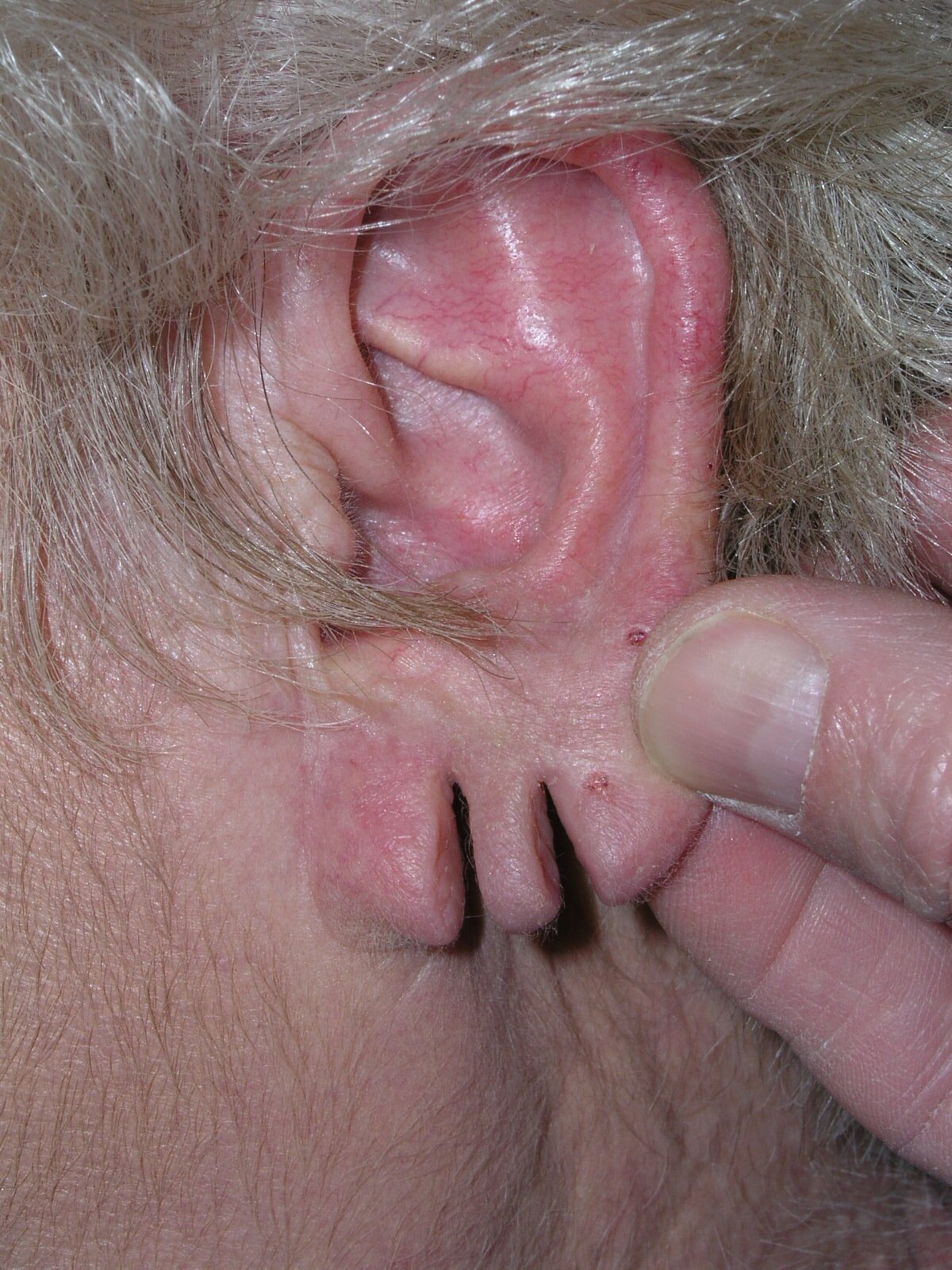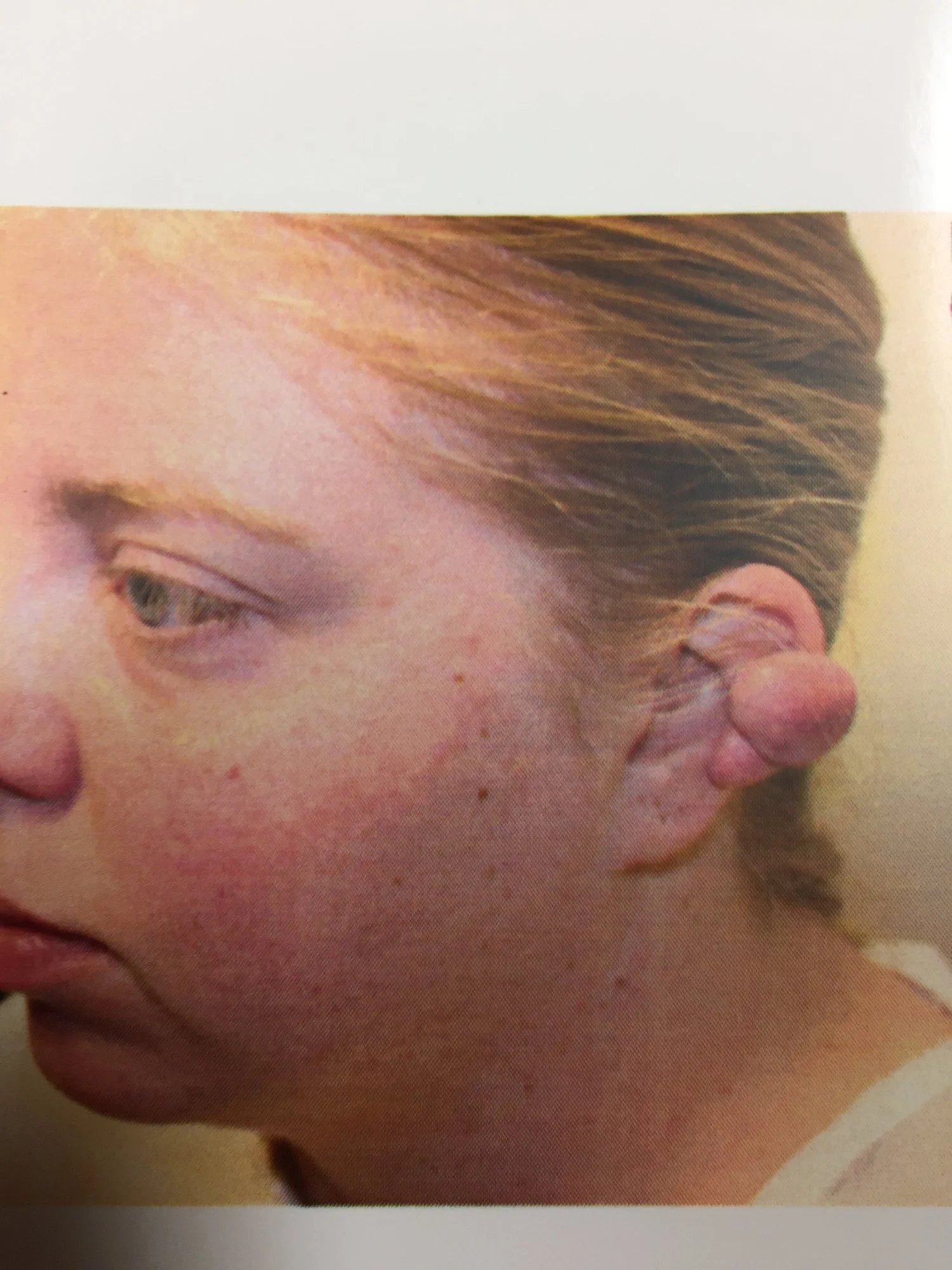
Ear
PLEASE NOTE THAT OUR SURGICAL CENTRE IS NOT EQUIPPED FOR PAEDIATRIC OTOPLASTY SURGERY.
CHILDREN LESS THAN 14 YEARS OF AGE MUST VISIT THEIR PAEDIATRICIAN FOR A REFERRAL TO A PAEDIATRIC PLASTIC SURGEON AT THE STOLLERY CHILDREN'S HOSPITAL WHERE THE SURGERY WILL BE PERFORMED UNDER GENERAL ANAESTHESIA.
*I DO PERFORM OTOPLASTY SURGERY ON ADOLESCENTS (14+):
THE SURGERY IS PERFORMED UNDER LOCAL ANAESTHETIC WITH THE PATIENT AWAKE FOR THE OPERATION.
IF THE PATIENT WOULD PREFER TO BE ASLEEP FOR THE OPERATION, THE SURGERY MUST BE PERFORMED AT THE STOLLERY CHILDREN'S HOSPITAL.
*DISCLAIMER: THIS SITE CONTAINS GRAPHIC & SURGICAL IMAGES THAT MAY BE DISTURBING TO SOME VIEWERS.
THIS SITE IS INTENDED FOR INDIVIDUALS OVER THE AGE OF 18.
**None of the images on this site have been enhanced or photoshopped.
*Tap a patient image to enlarge & view the full series of pre and post-operative images.
Before & After Photos
*Tap a patient image to enlarge & view the full series of pre and post-operative images.
Otoplasty - Ear Pinning
Before the Surgery:
+ What is ear pinning (otoplasty)?
PLEASE NOTE THAT OUR SURGICAL CENTRE IS NOT EQUIPPED FOR PAEDIATRIC OTOPLASTY SURGERY. CHILDREN LESS THAN 14 YEARS OF AGE MUST VISIT THEIR PAEDIATRICIAN FOR A REFERRAL TO A PAEDIATRIC PLASTIC SURGEON AT THE STOLLERY CHILDREN'S HOSPITAL WHERE THE SURGERY WILL BE PERFORMED UNDER GENERAL ANAESTHESIA.
*I DO PERFORM OTOPLASTY SURGERY ON ADOLESCENTS (14+):
THE SURGERY IS PERFORMED UNDER LOCAL ANAESTHETIC WITH THE PATIENT AWAKE FOR THE OPERATION. IF THE PATIENT WOULD PREFER TO BE ASLEEP FOR THE OPERATION, THE SURGERY MUST BE PERFORMED AT THE STOLLERY CHILDREN'S HOSPITAL.
The ear develops very early in childhood. By the age of 4-5 years, the ear is about 70-80% full grown, and by age 7-8 years old, the ear is close to an adult size.
Infants who are born with prominent ears can be treated conservatively with paper tape which will allow the soft infant cartilage to remodel and correct the prominence.
As the infant gets older, the cartilage matures and is less responsive to manipulation.
After the age of 6-9 months, a persistently prominent ear is less likely to respond to these conservative measures.
Children with persistently prominent ears can have a procedure called an Otoplasty to bring the prominent ears closer to the head.
This procedure is usually delayed until the child is 4-5 years old, but done before entering the first grade in school.
In addition to prominence of the ear, there may be some shape irregularity to the ear, and there may be asymmetry of ear shape and prominence when comparing one ear to the other.
The Operation:
+ How is the operation done?
In children, this procedure requires a General Anaesthetic
The surgery takes about one hour, and is a Day Procedure, where the child goes home the same day.
There are a number of different techniques to correct the ear prominence, and shape deformity, and the technique will be customized to the patient.
There is an incision made behind the ear, which will leave a scar along the back of the ear. This is well hidden.
The cartilage is then adjusted to correct the deformity.
The incision is closed with a dissolving suture.
The child wears a bandage around the ears and scalp for up to one week.
At one week following surgery, the bandage is removed and then the hair can be washed.
+ Is this surgery covered by AHS (Alberta Health Services)?
For children up to the age of 18 years, AHS will cover this procedure.
It is not covered by AHS for Adults
The Risks:
+ What are the risks of doing an Otoplasty procedure?
With any surgery there are surgical and anesthetic risks.
Aside from the rare risks of an anesthetic event, some of the general and specific surgical risks for this procedure would include:
- Scarring
- Infection of the incision
- Swelling and bruising- this is very minimal
- Sensation changes to the ear for up to 6 weeks
- Discomfort
- Time off school for children and work for adults
- Bleeding (hematoma)
- Asymmetry
- Relapse where the ear becomes prominent again. This is due to a cartilage suture breaking and is easily corrected by replacing the suture.
- Extrusion of the permanent cartilage suture which shows as a non-healing small scab along the incision line: This suture would require replacement.
This list is not complete.
**During the consultation with the patient, Dr. Giuffre will outline and explain each of the risks in detail.
The Followup:
+ How often do I need to come back for a checkup after the surgery?
Postoperative visits include:
- a 1 week visit
- a 6 week visit.
If there are any patient concerns, Dr. Giuffre provides his home phone number for patient's direct access.
After the 6 week visit, if there are any future requests for an appointment, they are made directly with Dr. Giuffre office and an expedited visit is arranged.
Financing:
+ How much does it cost?
This is considered a cosmetic procedure in adults (over the age of 18) and is not covered by Alberta Health Services.
It is covered by Alberta Health Services for children under 18 years of age.
The cost of cosmetic surgery is covered entirely by the patient.
The one fee would include:
the cost of the anesthetist if required (who provides the General Anesthetic)
the rental of the operating room and equipment
the staff including the nurses and administration staff
the surgical fee
The cost will vary depending on the duration of the procedure and the quality and sophistication of the surgical facility where the surgery is performed.
The fees will be discussed at the time of consultation with Dr. Giuffre.
There is no obligation to proceed with surgery following the consultation. The patient is referred to our web sites and is invited back for a second consultation if need be.
Our office will endeavour to expedite a surgical procedure to accommodate both business and family obligations.
All fees are receipted. GST payment is required.
+ Can I finance the costs of the surgery? How do I do this?
Dr. Giuffre does not provide in house financing for cosmetic procedures.
There are a number of companies across Canada that will finance cosmetic surgery not much different than financing a vehicle or mortgages. Please refer to the links provided for this information.
**Dr. Giuffre has no financial or business relationship or affiliation with any of these companies.
+ If something goes wrong, do I have to repay for the operation?
You do not have to pay for the treatment of an immediate complication. In the unusual event that there is a problem with your original surgery you do not have to pay for the correction.
+ What about having my Cosmetic Surgery in another country where it is cheaper?
There is a current trend to have surgery out of your country where the surgery may be cheaper.
We call this tourist surgery.
There are a number of additional risks associated with tourist surgery, which include:
The surgical skill, experience, licensing and education of an unknown surgeon.
Canada has very strict rules and requirements to be a licensed Plastic Surgeon (FRCS(C)) in our country. Your Plastic Surgeon has completed an undergraduate degree (4 years), an MD degree (4 years), a Fellowship Degree in Plastic Surgery (5 years) and often a post Fellowship (1-2 years).
A “friend” is not a good reference, nor is glitzy advertising.
The safety, sterility and equipment quality, including anaesthesia machines in the hospital or private surgical suite could be questionable; this may lead to increased risk of infection and anaesthetic risks.
Post operative care is limited to the time you spend in their country.
If you have a complication, to see your original surgeon, you will have to fly back to where your procedure took place, or see a new surgeon in your own Country.
If you have an unsatisfactory result, you will have to fly back to see your original surgeon or find a new Surgeon.
The cost of the repair may exceed what you originally paid, and the final result, fixing a mistake, is often not as good as it could have been had the surgery been done correctly the first time.
After accounting for the accumulated costs of the air travel, hotel, surgery and postoperative care, the perceived cost savings may not be significant.
If you have a severe, life threatening complication, Alberta Health Care will cover the medical costs for your care.
Correcting the reconstructive problem, as a result of the complication, would be the patient’s financial responsibility.
Torn Earlobes
Before the Surgery:
+ Can my enlarged ear piercing holes be corrected? I have torn the ear lobe?
Over time and with the use of heavy ear rings, the holes for the original ear piercing can enlarge.
This may cause a deformity in the ear lobe, or the earrings may sit asymmetrically or the earrings may not even stay in the holes.
Some patients have very large holes created by rings designed to enlarge the ear piercing holes.
If a hooped earring gets pulled firmly, the ear piercing hole can be torn all the way through the ear lobe leaving a cleft lobe after it heals.
+ My earlobes are too big. Can I have them made smaller?
The earlobe size can be reduced and the earlobe shape adjusted.
+ Is this surgery covered by AHS (Alberta Health Services)?
The ear lobe procedures are not covered by AHS.
+ How is this repaired?
The repair of a torn cleft ear lobe, a wide earhole piercing, large ear lobes or abnormal scarring is done under local anaesthetic.
The hole or the cleft is repaired and the hole is completely removed.
At 6 weeks after the repair, the patient can re-pierce the lobe.
The new piercing should not be made in the old scar from the repair because the scar will easily tear again.
Patients with very large holes, who no longer wish to have this style of earring, can have the ear lobe reconstructed and the large hole completely removed under local anaesthesia.
This procedure is done under local anesthetic and takes under one hour.
There will be stitches that must be removed in 5-6 days after surgery.
There is no down time.
The Risks:
+ What are the risks of doing an Otoplasty/Earlobe repair procedure?
With any surgery there are surgical and anesthetic risks.
Aside from the rare risks of an anesthetic event, some of the general and specific surgical risks for this procedure would include:
- Scarring
- Infection of the incision
- Swelling and bruising- this is very minimal
- Sensation changes to the ear for up to 6 weeks
- Discomfort
- Time off school for children and work for adults
- Bleeding (hematoma)
- Asymmetry
This list is not complete.
**During the consultation with the patient, Dr. Giuffre will outline and explain each of the risks in detail.
The Followup:
+ How often do I need to come back for a checkup after the surgery?
Postoperative visits include:
- 1 week visit
- 6 week visit
If there are any patient concerns, Dr. Giuffre provides his home phone number for patient's direct access.
After the 6 week visit, if there are any future requests for an appointment, they are made directly with Dr. Giuffre office and an expedited visit is arranged.
Abnormal Scarring after Ear Pearcing
Before the Surgery:
+ After ear piercing, I developed scarring at the site of the ear piercing. This has formed a big lump. What can I do?
There are occasional patients that develop a scar at the site of their piercing.
This often follows an infection or allergic reaction to the earrings.
Sometimes the scar is quite small and will resolve on its own or responds to conservative treatment like a steroid injection
The scarring can become quite large producing a significant cosmetic deformity.
Surgical excision of the scars with local reconstruction will eliminate the scar although, 10% of patients will develop a thicker scar than desired.
Early treatment with steroid injections in the new scar is used to treat this risk.
+ Is this surgery covered by AHS (Alberta Health Services)?
The ear lobe procedures are not covered by AHS.
The Followup:
+ How often do I need to come back for a checkup after the surgery?
Postoperative visits include:
- 1 week visit
- 6 week visit
If there are any patient concerns, Dr. Giuffre provides his home phone number for patient's direct access.
After the 6 week visit, if there are any future requests for an appointment, they are made directly with Dr. Giuffre office and an expedited visit is arranged.
The Risks:
+ What are the risks of doing the procedure?
With any surgery there are surgical and anesthetic risks.
Aside from the rare risks of an anesthetic event, some of the general and specific surgical risks for this procedure would include:
- Scarring
- Infection of the incision
- Swelling and bruising- this is very minimal
- Sensation changes to the ear for up to 6 weeks
- Discomfort
- Time off school for children and work for adults
- Bleeding (hematoma)
- Asymmetry
This list is not complete.
**During the consultation with the patient, Dr. Giuffre will outline and explain each of the risks in detail.
Enlarged Ear Piercing Repair
Before the Surgery:
+ Can my enlarged ear piercing holes be corrected? I have torn the ear lobe?
Over time and with the use of heavy ear rings, the holes for the original ear piercing can enlarge.
This may cause a deformity in the ear lobe. The earrings may sit asymmetrically, or the earrings may not even stay in the holes.
Some patients have very large holes created by rings designed to enlarge the ear piercing holes.
If a hooped earring gets pulled firmly, the ear piercing hole can be torn all the way through the ear lobe leaving a cleft lobe after it heals.
+ My earlobes are too big. Can I have them made smaller?
The earlobe size can be reduced and the earlobe shape adjusted.
+ After ear piercing, I developed scarring at the site of the ear piercing. This has formed a big lump. What can I do?
There are occasional patients that develop a scar at the site of their piercing.
This often follows an infection or allergic reaction to the earrings.
Sometimes the scar is quite small and will resolve on its own, or responds to conservative treatment like a steroid injection.
The scarring can become quite large producing a significant cosmetic deformity.
Surgical excision of the scars with local reconstruction will eliminate the scar, although 10% of patients will develop a thicker scar than desired. Early treatment with steroid injections in the new scar is used to treat this risk.
+ How is this repaired?
The repair of a torn cleft ear lobe, a wide earhole piercing, large ear lobes or abnormal scarring is done under local anaesthetic.
The hole or the cleft is repaired and the hole is completely removed.
At 6 weeks after the repair, the patient can re-pierce the lobe.
The new piercing should not be made in the old scar, from the repair, because the scar will easily tear again.
Patients with very large holes who no longer wish to have this style of earing can have the ear lobe reconstructed and the large hole completely removed under local anaesthesia.
This procedure is done under local anesthetic and takes under one hour.
There will be stitches that must be removed in 5-6 days after surgery.
There is no down time.
+ Is this surgery covered by AHS (Alberta Health Services)?
The ear lobe procedures are not covered by AHS
“Life is full of choices; your character reflects those choices.”





























